1- The first month
2- The second month
3- The third month
4- Four to five months
5- The fifth month and beyond
6- Birth
7- Mother and baby
=Glossary
=References
=Medical advisers
The
first month
Fertilisation
Every human being begins life as a single cell,
formed when father's sperm fertilises mother's
egg. Fertilisation normally takes place in the
mother's Fallopian tube, which connects the uterus
(womb) with the ovary. The uterus is the size
and shape of a large pear: it is made of muscle
and it stretches to allow the baby's growth throughout
the months of pregnancy.
A woman ordinarily has two tubes and two ovaries,
one at each side of her uterus. Every month one
of the ovaries in turn releases
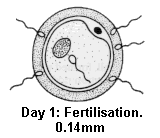
an egg (ovum) which passes slowly along the tube
towards the womb cavity
If the egg is not fertilised within 12 hours or
so of being released, it dies; it cannot develop
further. But if the woman has sexual intercourse
during the days of her monthly cycle just before
or at the time when an egg has been released from
the ovary, then many sperm cells released by her
partner may travel up to the Fallopian tube and
one may fertilise the egg. When fertilisation
is completed and the nuclei of egg and sperm have
combined, a new being comes into existence and
is capable of further development. Because the
parents are human - belonging to the species Homo
sapiens - the new being is also human. Fertilisation
(by which we mean conception) marks the beginning
of the human lifespan.
A consultant specialising in the care of pregnant
women writes: "Life does not begin with birth.
When born, we are already nine months old... we
have a responsibility to learn how to study the
life in utero, and how to care for it"1
Heredity
The cells of living beings contain DNA (deoxyribonucleic
acid), the substance in the nucleus that enable
cells to reproduce and transmit characteristics
from generation to generation. When cells divide,
the DNA takes the form of chromosomes - the units
carrying the genes that pass hereditary features
from parents to offspring. Different species have
varying numbers of chromosomes per cell: for example,
a mouse has 40 while a cat has 38. Human body
cells normally contain 46 distinctively human
chromosomes. But an egg and a sperm cell contain
only 23 chromosomes each, to allow for their adding
together at fertilisation: sperm and ovum are
termed gametes (from a Greek word for "marriage
partners"). When they "marry" they
make one completely new cell - the human embryo,
zygote or conceptus - with 46 chromosomes carrying
a fresh, unique combination of genes. At fertilisation
this human embryo is about 0.1mm in diameter.
Since characteristics come from both parents the
zygote is never the same as, or part of, the mother,
but is a genetically distinct individual. The
colouring of hair, skin and eyes, the sex of the
new human being, and factors influencing height
and build, are determined at fertilisation by
information on the DNA.
Gender
A baby's sex is determined at fertilisation. A
chromosome from the father's sperm determines
whether the child is male or female. If an X chromosome
is present the baby is a girl; if a Y chromosome
is carried by the sperm instead, the baby is a
boy.
Twins
Occasionally two eggs are released by the ovary
and fertilised. This results in fraternal twins
who are different in appearance and may be of
different sexes because their genes form from
two eggs and two sperm cells.
Rarely, one embryo splits into two and both cells
develop separately, as identical twins, similar
in appearance.
"They have the same genetic make-up and apparently
the whole genetic message is the same in both
of them. Nevertheless, they are obviously different
human beings."2
Blueprint, builder
and house
The embryo is not simply a set of instructions
for making a new human being, like a blueprint
for building a house. A blueprint is inert and
cannot carry out instructions, but the embryo
is active and begins work at once. A house needs
builders, carpenters, electricians and plumbers
to complete it; but the embryo has the ability
to grow spontaneously, moving on to other phases
of development and constructing the skeleton,
flesh, nerve connections and a waste disposal
system of the human body. After a house is built,
a blueprint remains separate; but the embryo -
already an essential human by virtue of the genes
- is blueprint, builder and "house"
together.
Implantation
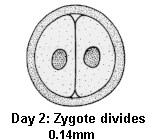 After fertilisation the single cell splits into
two, then the two cells double to four, four to
eight, eight to sixteen and so on. Because the
cell cluster looks superficially like a berry
it is called the morula (Latin for "mulberry"),
but the new life is always biologically human
(species Homo sapiens).
After fertilisation the single cell splits into
two, then the two cells double to four, four to
eight, eight to sixteen and so on. Because the
cell cluster looks superficially like a berry
it is called the morula (Latin for "mulberry"),
but the new life is always biologically human
(species Homo sapiens).
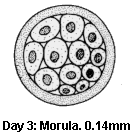
The
journey along the Fallopian tube continues slowly
for about four days. Growth increases. By the
time the womb cavity is reached, the cell cluster
becomes hollow and fluid-filled, and is referred
to as the blastocyst. However, this is not an
inert clump of cells but a busily developing human
individual: differentiation (organisation into
different parts and functions) is already taking
place. Meanwhile the uterus is forming a spongy
lining within which the embryo will implant. To
achieve this the embryo burrows into the wall
of the womb and is covered over by the lining
of the womb. This begins 6 days after fertilisation
and is completed within the next 7 days.
If
fertilisation has not taken place, the lining
of the uterus comes away at the end of the monthly
cycle as the woman's menstrual period. But once
implantation occurs, the embryo sends out a hormonal
signal which prevents the mother's period. This
is usually her first indication of pregnancy.
Estimating
length of pregnancy
Generally a woman does not know the exact date
of her baby's conception. When she misses a period
she may take a pregnancy test; she should see
a doctor promptly to obtain professional care
for herself and her child. The doctor takes the
date of the first day of the mother's last menstrual
period as the starting-point for a 40-week pregnancy.
This gives the baby's gestational age. However
since fertilisation only occurs when the ovum
is released from the ovary, some two weeks from
the beginning of the last period, the baby's actual
(conceptional) age is also two weeks less. Full-time
delivery occurs 38 weeks after fertilisation,
but 40 weeks after the mother's last menstrual
period. (In this booklet all developments of the
embryo and foetus are dated from the time of conception,
or fertilisation unless stated otherwise.)
Protection and life
support
During and after implantation
the embryo develops a protective, fluid-filled
capsule which surrounds and cushions the developing
body to prevent injury. Embryo and fluid are enclosed
in two membranes, an inner amnion and an outer
chorion. The chorion is covered in rootlike tufts,
some of which form the early placenta - an organ
made by the baby and the mother which transfers
nutrients from the mother's bloodstream and removes
waste products from the child's, though mother's
and baby's circulatory systems remain separate.
The placenta also produces hormones to maintain
the pregnancy. In the ninth month it will alter
the mother's hormonal balance and triggers off
the birth process - although we are still unsure
what causes labour to begin.
The baby is connected to the placenta by the umbilical
cord, the lifeline channelling nourishment in
and taking wastes out, which will be cut close
to the baby's abdomen at birth and will leave
the mark of the navel. During pregnancy the baby
obtains oxygen from the mother's blood via cord
and placenta, so does not drown in the surrounding
fluid.
Body
development
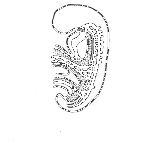
By 25 days from fertilisation the body is developing.
Head and trunk appear and tiny arm buds begin
to form, followed by leg buds. The early embryo
seems to have a "tail", but this is
really a protective covering for the spinal cord.
Because the central nervous system (brain. spine
and spinal cord) is so important, governing sensory
and motor functions, the embryo's body is designed
for rapid growth of head and back.
By 21 to 25 days the baby's heart is beating.
Other internal organs are present in simple form
and functioning as they grow. Early facial features
appear. The doctor who performed the first-ever
blood transfusion to an unborn baby has described
the embryo at the end of the first month from
fertilisation:
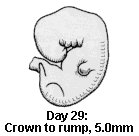
"By 30 days, just two weeks past mother's
first missed period, the baby - one quarter of
an inch long - has a brain of unmistakable human
proportions, eyes, ears, mouth, kidneys, liver,
an umbilical cord and a heart pumping blood he
has made himself."3
The
second month
Growing
The embryo increases in size from 5mm at four
weeks to 4Omm by the end of the eighth week. The
baby in the womb is usually measured from the
top of the head to the bottom of the spine (crown-rump
lengths).
Hands and feet
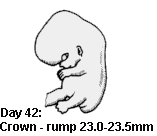 By
the sixth week from fertilisation tiny fingers
appear, followed within days by the toes. By the
seventh week the baby has individual fingerprints;
no two sets of fingerprints are ever the same.
Even in utero the baby has unique characteristics.
By
the sixth week from fertilisation tiny fingers
appear, followed within days by the toes. By the
seventh week the baby has individual fingerprints;
no two sets of fingerprints are ever the same.
Even in utero the baby has unique characteristics.
Eyes and ears
By six weeks the eyes which appeared in simple form
in the first month develop lens and retina; the
eyelids start to take shape.
The ears continue to develop: by seven weeks the
outer ear is present, and the inner ear, with
its hearing and balancing mechanisms, is well
established (see page 15 'Hearing')
Movements
Spontaneous movements begin at seven weeks:
"By 45 days, about the time of the mother's
second missed period, the baby's skeleton is complete
in cartilage, not bone, at first; ... he makes the
first movements of his body and new-grown limbs,
although it will be another 12 weeks before his
movements are strong enough to be transmitted through
the insensitive uterus to be detected by the mother's
sensitive abdominal wall."4
Brain
function
Brain waves have been recorded by EEG (electro-
encephalograph) in the human embryo 40 days after
fertilisation.5
Response to touch
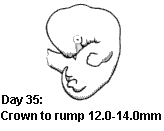 Human embryos of five weeks gestational age have
been seen to move away from an object touching
the mouth area. The sensitive area extends to
include the rest of the face in the sixth and
seventh weeks and the palms of the hands and soles
of the feet in the eighth and ninth weeks respectively.6
Human embryos of five weeks gestational age have
been seen to move away from an object touching
the mouth area. The sensitive area extends to
include the rest of the face in the sixth and
seventh weeks and the palms of the hands and soles
of the feet in the eighth and ninth weeks respectively.6
A
British study shows that the baby's movements
begin at the same time as sensory nerves begin
to grow into the spinal cord in the second month
of pregnancy; the nerve fibres respond to touches
to the skin and movement of the limbs: at this
stage the baby's sensory nerves "appear to
be more sensitive than those of the adult or newborn
baby."7
From
embryo to foetus
Around eight weeks the baby's cartilage skeleton
begins to turn into bone. The body is essentially
complete. Now the baby can be referred to as the
foetus - a Latin term meaning "young, offspring."
Latin- or Greek-derived names are given to human
beings at successive phases of development, e.g.
"zygote" for the newly-conceived, "neonate"
for newborn baby, "adolescent" for growing-up
teenager, "geriatric" for a pensioner.
These terms simply identify different stages in
the human lifespan which begins at fertilisation.
The third
month
Development
By the end of the twelfth week the baby measures
almost 90mm and weighs 45g. The baby's face, at
first broad, now becomes narrower; the eyes are
closed for protection from about 10 weeks until
the sixth month. Boyhood or girlhood is now obvious.
Sensitivity
Two British consultants, one caring for pregnant
women and the other for children after birth,
describe human development at this stage:
"Nine weeks after conception the baby is well
enough formed to bend his fingers round an object
in the palm of his hand. In response to a touch
on the sole of his foot he will curl his toes or
bend his hips and knees to move away from the touching
object. At 12 weeks he can close his fingers and
thumb and he will open his mouth in response to
pressure applied at the base of his thumb."8
From
a simple, generalised response to stimulation
at 6 weeks gestational age, the foetus develops
an almost complete range of responses to touches
on the skin by 12 weeks.9
Feeling
pain
The brain and nerve fibres must be functioning
for anyone to feel pain
Brain cells which are essential for consciousness
in the adult are known to be present in the foetus
by 10 weeks. Nerve fibres which transmit pain impulses
are known to be present before fibres inhibiting
pain are completed.
According to a scholarly study of the available
evidence, this "implies that the first trimester
foetus may be more susceptible to pain than slightly
older subjects."10. The first trimester of
pregnancy is the first three months.
In other words, if the baby can experience pain
before the body's mechanisms to suppress pain have
developed, this means that the baby may be able
to feel pain at a much earlier stage than was previously
thought, and perhaps even more keenly in the first
three months of pregnancy than later.
The same study concludes that there is a likelihood
that the
"foetus has started to acquire a sentient capacity
perhaps as early as six weeks, certainly by nine
to ten weeks of gestation. Anatomical examination
of such foetuses indicates the probability that
differentiation sufficient for reception, transmission
and perception of primitive pain sensation has already
occurred."11
Practising
for life outside the womb
"At 11 weeks after conception the foetus
starts to swallow the surrounding amniotic fluid
and to pass it back in his urine. He can also
produce complex facial expressions and even smile."12
Swallowing prepares the baby for taking in milk
at birth. Thumb-sucking has also been recorded
in the foetus.13
Foetal breathing movements have been detected
as early as 11 weeks 14. Although the baby does
not breathe air inside the fluid-filled amnion,
these movements help develop the respiratory organs.
Four to
five months
Enlargement of baby and uterus
By sixteen weeks the baby measures 140mm from
crown to rump, just over one third of the size
he or she will be at full term, and weighs around
200g. The heart now pumps 30 litres of blood a
day. The uterus expands and changes shape to accommodate
the growing baby; pregnancy begins to show externally.
The doctor can tell approximately how advanced
the pregnancy is by locating the fundus (the top
part of the uterus between the Fallopian tubes,
which stretches upwards towards the mother's chest
as the uterus expands).
Hearing
There is evidence that from four months the foetus
responds to sound. Doctors testing unborn children
for deafness, while monitoring their reactions
to noise with ultrasound (a technique for visualising
the children in utero), have observed eye movements
and "blink-startle" responses in foetuses
of 16 to 32 weeks gestation.15
The authors of a textbook on the unborn which is
used in medical schools world-wide explain why the
foetus can hear while immersed in fluid:
"The ears of the foetus function as early as
the fourth month, and there is evidence that it
hears a good deal. One might object that if a person
dives under water and someone else talks to him
he hears only a muffled sound. This is true. The
sound is muffled by the cushion of air remaining
in the auditory canal outside the ear drum. But
the foetus living in the amniotic fluid has no muffling
air cushions around its ear drum - and water conducts
sound better than air does. The silent world of
the foetus (or, below the surface of the ocean)
is a fantasy, unfounded in reality."16
The
baby hears sounds from the outside world as well
as from the mothers heart and digestive system:
"In fact the inner ear of the foetus is completely
developed by mid-pregnancy, and the foetus responds
to a wide variety of sounds. He is surrounded
by a constant very loud noise in the uterus -
the rhythmical sound of the uterine blood supply
punctuated by the noises of air passing through
the mother's intestine. Loud noises from outside
the uterus such as the slamming of a door or loud
music reach the foetus and he reacts to them."17
Tests using different types of music indicate
that the baby even appears to have preferences:
"A four- or five-month-old foetus definitely
responds to sound and melody - and responds in
very discriminating ways. Put Vivaldi on the record
player and even the most agitated baby relaxes
... In a film made at the City of London Maternity
Hospital, Yehudi Menuhin demonstrated that it
was possible to contact the unborn via music."18
Babies learn to recognise their mothers' voices
whilst in the womb 19 and even to recognise stories
which are read to them in the womb.20 Newborn
babies whose mothers watched Neighbours during
pregnancy have been seen to stop crying and become
alert when they hear the theme tune after birth.21
Sensitivity
to light
From the sixteenth week the foetus responds to
light. If a blinking light is shone on to the
mother's abdomen, the foetal heartbeat fluctuates.22
"In late pregnancy, some light penetrates
through the uterine wall and amniotic fluid, and
foetal activity has been shown to increase in
response to bright light."23 The womb is
a more stimulating environment than some people
think; its occupant is alert and responsive.
The fifth month and beyond
After
20 weeks the baby is 190mm from crown to rump
and weighs 460g. Head hair, eyebrows. eyelashes
and nails are growing. To protect the baby's skin
from prolonged contact with the amniotic fluid,
a greasy substance called vernix covers the body.
Between this stage and birth the baby will gain
weight and will develop an insulating layer of
fat beneath the skin. He or she will also receive
maternal antibodies against some infections as
a temporary protection until the infant's own
immune system is better developed.
Waking
and sleeping
Foetal activity is affected when the mother is
tired or under stress.24 The baby is usually most
notably active when the mother is lying down at
night. The mother feels the baby's kicking and
may notice sharp movements when the baby gets
hiccups after drinking the amniotic fluid or practises
its breathing movements. In later pregnancy the
foetus has been observed to show "behavioural
states" - waking, calm sleeping, and "rapid
eye movement sleep" which is associated with
dreaming in adults.25
The quest for comfort
The baby still has some room to manoeuvre inside
the womb and seeks the position which feels most
comfortable:
"It is very easy to demonstrate now with
ultrasound that the babies make the most of all
the space and room available to them ... We know
that foetal comfort determines foetal position,
that changes in maternal position provoke baby
to seek a new position of comfort."26
Survival
outside the womb
If the baby is born too early, there is still a
good chance that he or she will survive, given special
medical care. A document from the Royal College
of Obstetricians and Gynaecologists (the professional
body of doctors who treat pregnant women) states:
"In 1984, 72 per cent of liveborn infants of
22 to 27 weeks' gestation born at the Bristol Maternity
Hospital survived, as did 64 per cent of infants
of 500 to 999 grammes birthweight."27
These percentages had increased from previous
years. With advances in technology and in understanding
of human foetal development, premature babies'
chances of survival are improving.
These figures refer to the length of the pregnancy
from the time of the mother's last menstrual period.
and not to the age of the baby from fertilisation.
which would usually be two weeks less. (see 'Estimating
length of pregnancy', section 1, above)
Birth
Labour and delivery
In the last weeks of pregnancy the baby lies head
downwards, as the head is normally the first part
to emerge at birth. Occasionally, if a baby's
position of personal comfort is not changed to
fit in with the normal birth process, there may
be a "breech" presentation - rear end
first - which needs medical attention.
The mother's labour begins as (following hormonal
signals including that from the placenta) the muscular
uterus contracts to expel the baby. The cervix (neck
of the womb) gradually opens to allow the baby to
pass into the vagina (birth canal). The amnion tears
and releases its fluid (this is often referred to
as "the waters breaking"). Contractions
become more frequent as the baby is pushed through
the cervix and vagina. If the mother has attended
ante-natal classes she will have learned what to
expect and how to control her breathing and pushing
process. A midwife and/or a doctor supervises the
mother and baby during labour. The baby's father
may wish to be present to lend support and encouragement
and to see his baby from the moment of birth.
After labour, which varies in length but usually
lasts some hours, the baby is born. A gasp and a
cry start the lungs working. The umbilical cord
is cut and the baby is examined and weighed. Normal
birthweight is approximately 3,400 grammes or about
7½ lb, but considerable variations sometimes
occur because of genetic factors, health problems
and outside influences such as the mother's smoking
during pregnancy.
Finally the membranes and placenta are expelled.
The baby no longer needs a direct life support
system as he or she can now breathe air and take
milk.
The same before and after birth
After delivery babies who have been studied in
utero show the same individual behaviour that
was observed while they were in the womb: "After
birth you see many babies sleeping in the odd
positions that they chose to rest in within the
uterus prior to birth ... The good drinkers in
utero are the good drinkers in the nursery and
the dainty, tedious swallowers in utero are the
tedious ones out of the uterus as well ... The
behaviour traits also bridge the birth."28
From the one-celled zygote to the multi-million-celled
infant and adult, every human being is a distinct
individual.
Mother and baby
Ante-natal care
A doctor caring for a pregnant woman has two patients,
the mother and the baby. As soon as he is aware
of the pregnancy, the doctor will take the needs
of both into account.
The doctor should know about a pregnancy as early
as possible so that any medicines he prescribes
are safe for both his patients. This is particularly
important as the pregnancy may, of itself, cause
symptoms such as headaches and fatigue for which
the mother may seek medical treatment. If the mother
has "morning sickness", caused by normal
hormonal responses to pregnancy, a harmless antacid
can be given. Tablets of iron and folic acid (a
B vitamin) are routinely prescribed to prevent anaemia:
it is safe and important to take these.
Pregnancy can also lead to an increased sense of
well-being and contentment. Many women find that
their complexions improve and they feel more relaxed
as a result of the hormonal changes in their bodies.
During pregnancy the mother should attend her doctor's
ante-natal clinic for regular checks on her weight
and blood pressure, and on her baby's heartbeat,
growth and position in the uterus. Arrangements
will be made for the baby's birth at home or (more
likely) in hospital. Mother and perhaps father may
also attend parentcraft classes: there they will
learn how the baby develops, how to care for mother
and child before and after birth, and how to cope
with the process of birth itself.
The mother does not need to "eat for two"
in the sense of increasing her food intake. Adequate
amounts of protein, vegetables, fruit and milk should
be taken (particularly milk, since the mother needs
to replace the calcium taken from her system to
make the baby's bones). The doctor will advise on
any special dietary needs. During pregnancy a mother
can expect to gain around 12kg (allowing for baby.
placenta, fluid and her own physical changes), but
weight gain should not be excessive and too much
carbohydrate should be avoided.
Foetal breathing movements are substantially decreased
if the mother smokes cigarettes during pregnancy.
There is evidence that prematurity, stillbirth and
slower development may be related to this practice.29
It is important not to smoke during pregnancy or
when near a pregnant woman.
Even moderate amounts of alcohol taken in early
pregnancy may affect the child's growth and development
(including that of the brain); heavy drinking
carries a still higher risk.30 During the first
three months of pregnancy the developing baby
may be harmed by certain infections and drugs.
For example, rubella (German measles) may damage
the baby's heart, eyes or ears if the mother contracts
it in early pregnancy. Such harm can be prevented
by receiving immunisation against rubella as a
small child or as a schoolgirl, long before pregnancy
occurs. However, by the end of the third month
the baby is less likely to develop a disability
because the body is well developed.
Post-natal
care
Mother and baby will be visited by the midwife
for some days after the birth to check that all
is well with both of them. The mother should return
to her doctor six weeks later for her post-natal
examination to be sure that the uterus has regained
its former shape and that she is otherwise in
good health.
Glossary
| amnion |
the
fluid-filled membrane enclosing the baby in
the womb. |
| ante-natal |
before
birth. |
|
blastocyst (Greek, "sprout pouch') |
the
hollow, fluid-filled ball of cells which is
the developing embryo at one week after fertilisation. |
| cervix |
neck of the womb. |
| chorion |
the outer capsule containing amnion, fluid
and baby within the womb. |
| chromosome |
part of a cell nucleus, made of DNA, carrying
the genes; each species of animal and plant
has a characteristic number of chromosomes
per cell, except in reproductive cells which
have only half that number to allow for their
combination at fertilisation. |
| differentiation |
development of cells to perform specialised
functions (making nerves, bones, organs etc.). |
| DNA (deoxyribonucleic acid) |
threadlike molecule in the nucleus of a
living cell which can reproduce itself and
transmit hereditary characteristics. |
| EEG (electroencephalograph) |
an instrument which detects and records
brain activity. |
| embryo (Greek, "to teem within") |
stage of human development during the first
eight weeks after fertilisation. |
| fallopian tubes |
two tubes, one on each side of the womb,
connecting it with the ovaries; fertilisation
normally takes place in one of the Fallopian
tubes. |
| fertilisation |
the joining of sperm with ovum, completed
when their nuclei are combined, to make a
genetically new individual. |
| foetus (Latin, 'young, offspring') |
the developing human from eight weeks after
fertilisation up to birth. |
| fraternal twins |
twins who do not look alike because they
develop from two different eggs and sperm
cells. |
| full-time delivery |
birth of a baby after a completed nine-month
pregnancy (i.e. not a premature birth). |
| fundus |
the top part of the womb, lying between
the Fallopian tubes, which expands upwards
as pregnancy advances and enables the doctor
to assess the length of pregnancy. |
| gamete (Greek, "marriage partner") |
reproductive cell; egg or sperm. |
| gene |
a factor controlling inheritance of one
particular characteristic (e.g. brown eyes). |
gestational age
|
the baby's age calculated by estimating
pregnancy as starting from the first day of
the mother's last menstrual period. |
| hormone |
substance produced by an organ or a gland
which influences other organs or the whole
body. |
| homo sapiens (Latin, "thinking man") |
the human species. |
| identical twins |
twins who look alike because they result
from one egg and sperm when the zygote splits
into two separately developing cells. |
| labour |
the process of expelling baby, membranes
and placenta from the womb. |
| morula (Latin, "mulberry") |
the earliest stage of human embryo development;
the first four days of life when the growing
cell cluster looks like (but is not) a berry. |
| ovary |
the egg-producing organ; normally a woman
has two ovaries which take turns to release
one egg per month. |
| ovum |
egg (plural ova). |
| placenta |
a temporary organ within the uterus which
transfers nourishment and oxygen from the
mother, removes waste products from the baby,
and makes hormones to maintain and end pregnancy.
Expelled after the baby is born, it is then
also known as the "afterbirth". |
| post-natal |
after birth. |
| prematurity |
the baby is born before 37 completed weeks
since the mothers last period and needs special
care. |
| sentient capacity |
the ability to feel sensations such as
pain. |
| stillbirth |
the baby is born dead. |
| trimester |
a three month period of pregnancy. The
first trimester covers the first to the third
months; the second trimester the fourth to
the sixth months; and the third trimester
the seventh to the ninth months. |
| ultrasound |
a technique for viewing the unborn child:
high-frequency sound waves directed through
the mothers abdomen send back signals which
are converted to images on a screen. |
| umbilical cord |
a temporary lifeline connecting the unborn
child with the placenta, channelling nourishment
from the mother and removing wastes from the
baby. |
| uterus |
the womb; in utero (Latin) in the womb. |
| vagina |
the birth canal. |
| vernix |
a greasy coating protecting the unborn
baby's skin from prolonged contact with the
fluid in the amnion. |
| zygote (Greek, 'joining') |
the new, one-celled being formed when sperm
fertilises egg; the zygote of the species
Homo sapiens is a human being at the earliest
stage of life. |
References
*1- J.M.
Beazley, "Assessment of life in utero",
Nursing Times, 8 May 1980.
*2- Jérôme
Lejeune, quoted in Professor Jérôme
Lejeune and Professor Sir Albert William Liley,
The Tiniest Humans, editor Robert Sassone, 1977.
Library of Congress No. 77-7681 1, p.69. The Tiniest
Humans is composed from transcripts of testimonies
given by Professors Lejeune and Liley to the Sub-Committee
on Constitutional Amendments of the Committee
on the Judiciary, US Senate, 93rd Congress, 2nd
Session. 7 May 1974. and the Royal Commission
on Contraception, Sterilisation and Abortion,
New Zealand, 1977.
*3- Sir
William Liley, quoted in The Tiniest Humans, as
above, p. 16.
*4- Sir
William Liley, quoted in The Tiniest Humans, as
above. p.16.
*5- H. Hamlin,
Life or Death by EEG, Journal of the American
Medical Association, 12 October 1964.
*6- T. Humphrey,
"Some correlations between the appearance
of human fetal reflexes and the development of
the nervous system", Progress on Brain Research
(1964). 4. 93-135.
*7- "Earliest
feelings help to develop the senses", New
Scientist, 7 May 1987. reviewing the research
of Maria Fitzgerald published in Nature. 9 April
1987. vol. 326, p. 603.
*8- H.B.
Valman and J.F. Pearson. "What the foetus
feels", British Medical Journal, 26 January
1980.
*9- I.D.
Hogg, "Sensory nerves and associated structures
in the skin of human foetuses of 8 to 14 weeks
of menstrual age correlated with functional capability".
Journal of Comparative Neurology (1941), 75. 371-410.
*10- Peter
McCullagh, The Fetus as Transplant Donor--Scientific,
Social and Ethical Perspectives, John Wiley &
Sons 1987. p. 132.
*11- ibid.
*12- H.B.
Valman and J.F. Pearson, op.cit.
*13- Sir
William Liley. quoted in The Tiniest Humans, as
above, p.31.
*14- J.M.
Beazley. op.cit.
*15- J.C.
Birnholz et al. "The development of human
fetal hearing", Science (1983), 222. 516-518.
*16- M.
Furuhjelm et al. A Child is Born, Delacorte Press/Seymour
Lawrence 1977. p. 116.
*17- H.B.
Valman and J.F. Pearson, op.cit.
*18- Thomas
Verny with John Kelly, The Secret Life of the
Unborn Child, Sphere Books. 1987. pp. 7-8. 26.
*19- A.J.
DeCasper & W.P. Fifer, "Of Human Bonding:
Newborns Prefer their Mothers' Voices". Science,
208. 1174-1176.1980.
*20- A.J.
DeCasper & M.J. Spence, "Prenatal maternal
speech influences newborns' perception of speech
sound", Infant Behaviour and Development,
9, 133-150, 1986.
*21- P.G.
Hepper,, "Fetal 'Soap' Addiction", The
Lancet, p.1347. 11 June 1988.
*22- Sir
William Liley, "The Fetus as a Personality",
The Australian and New Zealand Journal of Psychiatry
(1972), 6, 99-105.
*23- H.B.
Valman and J.F. Pearson, op.cit.
*24- ibid.
*25- J.O.
Drife, "Can the foetus listen and learn?",
British Journal of Obstetrics and Gynaecology
(1985), 92, 777-779.
*26- Sir
William Liley, quoted in The Tiniest Humans, as
above, p.23.
*27- Royal
College of Obstetricians and Gynaecologists, Preterm
Labour and its Consequences, 1985, p. 295.
*28- Sir
William Liley, quoted in The Tiniest Humans, as
above.
*29- F.
Manning, "Meeting of Royal College of Physicians
and Surgeons", Family Practice News, 15 March
1976.
*30- J.W.
Hanson et al. "The effects of moderate alcohol
consumption during pregnancy on fetal growth and
morphogenesis". Pediatrics (1978), 92, 3,
4574W.
Medical
advisers
* Professor
Hubert Campbell, Emeritus Professor of Medical Statistics,
University of Wales
* Professor
Sir John Dewhurst, former President of the Royal
College of Obstetricians and Gynaecologists
* Professor
Peter Gray, Emeritus Professor of Child Health,
College of Medicine, University of Wales
* Dr Michael
Jarmulowicz, Lecturer in Histopathology, Royal Free
Hospital School of Medicine
* Miss Mary
Langdon-Stokes, Honorary Consultant Obstetrician
and Gynaecologist
* Dr Elliott
Larson, Scientific Staff, Clinical Research Centre,
Consultant Physician, Northwick Park Hospital
* Professor
John Marshall, Emeritus Professor of Clinical Neurology
University of London
* Dr John
McLean, Senior Lecturer in Embryology and Anatomy,
University of Manchester
* Professor
David Morrell, Professor of General Practice, Guy's
Hospital & St Thomas' Hospital
* Professor
David Short, Emeritus Professor of Clinical Medicine,
University of Aberdeen
* Professor
Ronald Taylor, Department of Obstetrics and Gynaecology
St Thomas' Hospital
* Dr Margaret
White, General Practitioner
Ref:
SPUC